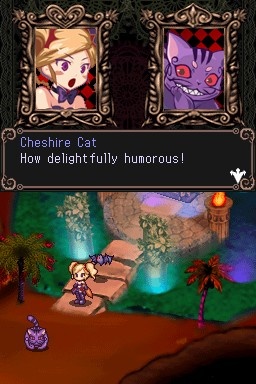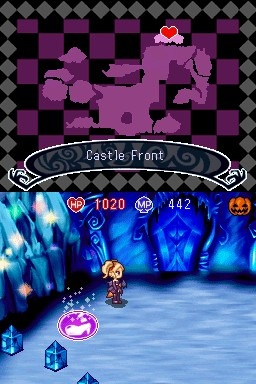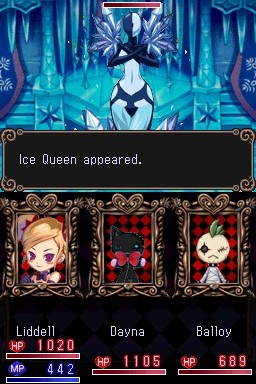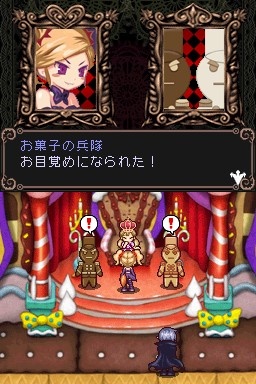Packed with allusions to Alice in Wonderland and defined by a gothic art style, A Witch's Tale is a role-playing game with tons of promise. Unfortunately, that promise goes almost totally unfulfilled. A Witch's Tale's style cannot overcome the realities of its tepid combat and dull story. Even if the combat and the storyline weren't such bores, the main character is one of the most repellant and unlikable protagonists you'll ever encounter. There are too many excellent RPGs on the DS to be subjected to this one.

You play as a young witch named Liddell who attends a magical academy. She begins the game by deliberately unlocking an ancient evil for no reason other than a desire to see harm done. She's warned by another student not to, and she's warned by a guardian vampire not to, but she just goes ahead while proclaiming a general desire to see some damage. That's not actually the problem with Liddell, though. There's a place for awful wretches as protagonists. Particularly in RPGs and strategy games, playing a bad guy or girl is as easy as making the invading enemy paladins instead of orcs.
The problem with Liddell is that she suddenly flip-flops after she releases this 1,000-year old evil, the Eld Witch, allowing herself to be guilt-tripped into venturing out and taking care of this problem she's created. She spends the entire game undoing the damage done to a half-dozen magical kingdoms, despite the fact that Liddell opened the game with a positive thirst for bloodshed. And while Liddell is out doing good work, she still shoots her mouth off about her desire to trash things. This storytelling attempts to show us a young, powerful witch growing up, but what's delivered is a young brat whose motivations are impossible to sympathize with, let alone understand. The eventual reveal of Liddell's tragic youth doesn't do anything but make her a brat with a sob story.
The magical kingdoms could have pulled the story out of this nosedive if it were actually worth caring about them. You explore each of these six magical kingdoms (and a few special levels) in a linear order, freeing them from the Eld Witch's magic and becoming more powerful as you go. All the world maps display the map itself on the top screen and the play area on the bottom, with each one is designed around one element. Desert, winter, and ocean worlds are in there, as per RPG/adventure game design requirements, but there are a few more interesting choices. The game opens with Candyland, which is where gingerbread men live and chocolate lakes are major terrain elements. Your home base is a plane of shadows, the literal shadows of the Eld Witch's victims a millennium ago. The whole setting is rife with Through the Looking Glass character cameos and style. But despite a few neat concepts, each world is really just a tedious dungeon.

To free a world from the Eld Witch's curse, you have to get into its castle and free its ruler, which entails gathering a few items from across that world and forge a key. The ensuing travel sends you across repetitive terrain tiles to fight a paltry few enemy types. Even "world" is a misnomer, but there's no good word for "collection of uninspired and linear map sections." A sparse assortment of characters occupy each world, but they're little more than signposts to point you to the key items. Once you've heard which direction you have to go, there's no more incentive to talk. The characters certainly don't have anything interesting to say.
Once you're in the world's castle, you fight a boss monster. It's usually a powerful servant of the world's ruler but under the control of the Eld Witch. Once you defeat the boss, the ruler is freed from its unique variant of Eld Witch-inflicted-paralysis. As thanks, the ruler gives you the means to reach the next world. It's not much more interesting than being told "your princess is in another castle!" A climactic boss fight could have been worth looking forward to, but the poor game mechanics keep these encounters from being any fun.
Combat pits one to three enemies against Liddell and her (up to two) party members. Her party members are gothic-styled puppets that you find throughout the worlds. However, they do not have storylines to follow or lines to speak, which keeps the story dull as rocks and centered on the awful Liddell. In combat, each puppet has its own hit point pool and a limited selection of abilities. But Liddell's magic point pool is shared through the entire party, and combat is only lost if Liddell dies. So really, Liddell doesn't have party members--she has equipment that grants extra actions and hit points.

Combat encounters are random. You can attack physically, attack with magic, use items, or run away. Liddell is specialized in magical attacks, with a wide array of attack spells at her disposal. Each puppet specializes in a specific function, such as physical attacks, healing, or fire magic. Some enemies have specific weaknesses, but combat isn't challenging enough to make that worth consideration. If you simply throw your most powerful attacks and spells every round you'll have earned enough experience to level up by the time you get low on hit points or magic. When you level up, you get all your magic and hit points back. Functionally, you have infinite health and magic pools. It's too simplistic and too easy to be at all rewarding.
Puppets that aren't in your party gain experience as they sit in the background, but this isn't a game where you need to worry about experience levels. Because combat is balanced toward a zero-death play-through, enemies do very little damage and die quickly. The biggest threat most enemies pose is to your patience, with tons of random encounters against enemies who should know better. How many monsters have to die before they all talk as a group to realize that they're one-shot kills and should leave you alone? The boss fights in each castle are simply longer versions of the rest of the game's combat. The boss has no chance of victory, you have no chance of defeat, and the whole affair is just awkward.
A Witch's Tale also features a touch-pad-only control scheme, with no option for traditional D pad and face button controls. Unfortunately, it would be substantially easier to move your character through the game's 2D maps with the D pad. The pedestrian combat of attack, run, item, and magic could be easily handled by the face buttons. Instead, you have to tap your choice of action (and your subchoice for magic and item use) and then drag the selection to your target's icon. You have to do this for every character in every round of every combat, which quickly becomes physically and emotionally tiresome. The touch-screen controls are also imprecise, making it difficult to reliably move from area to area or activate items on the map (by tapping on them, of course). As a bit of insult to injury, there's no need for the touch-pad-only controls because the face buttons and D pad are unused throughout the game.

The one high point to A Witch's Tale is the game's style, which is a gothic 2D delight. Liddell is a dark-clad heroine of gothic-cosplay hopes and dreams. She has a clear style and a charming habit of whirling her umbrella when you leave her idle. The interpretations of the key cast members of Through the Looking Glass delight, as does a hut-less Baba Yaga (if you're into Russian folklore). Thanks to sticking to 2D for the individual world maps and combat, A Witch's Tale is a crisp look at some reinterpreted fables. Sadly, solid art isn't anywhere near enough to salvage this game, and besides, there's not quite enough art to go around. You'll see plenty of "new" enemies who are just old enemies with new color schemes and stat blocks, as well as map elements that are used over again within each world. It's an interesting design that's been dully done.
A Witch's Tale is a disappointing attempt at an RPG. Combat never challenges you, worlds are drearily executed even when they have interesting ideas at heart, and your main character is loathsome. Why waste your time on a deeply flawed RPG when there are so many excellent ones available on the same platform?